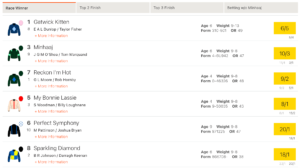Betting Odds Explained: A Beginner’s Guide
If you’re new to betting, one of the first things you should do is learn how betting odds work. It’s critically important because it allows you to understand how likely an event is to happen, and what your potential winnings will be. At first, it may appear confusing but we’re to help with our betting odds explainer.
What Are Betting Odds?
In betting, odds serve as the ratio between the stakes placed by the parties involved in a wager or bet. For instance, odds of 3 to 1 indicate that the first party, typically the bookmaker, stakes three times the amount wagered by the second party, commonly known as the bettor.
What Is Probability?
At the most basic level, betting provides you with the ability to predict the outcome of a certain event. If your prediction is correct, you will win money.
For any given event, there are a certain number of outcomes. Take rolling a dice for instance. If someone rolls a dice, there are six possible outcomes. Therefore, if you bet that the person rolls a ‘one’, there is a 16.67% chance that will happen.
Using Betting Odds to Calculate Probability
Whenever you see two numbers separated by a trailing slash, i.e. 4/1, this is known as fractional odds. From this, you can calculate how likely a given event is to happen with a calculation. For ease of explanation, let’s replace the numbers with letters i.e. 4/1 becomes A/B. Here is the calculation: Probability (%) = B / (A+B).
- 9/1 can be calculated as 1 / (9 + 1) = 0.10 – There is a 10% chance that the event will happen.
- 4/1 can be calculated as 1 / (4 + 1) = 0.20 – There is a 20% chance that the event will happen.
- 1/1 can be calculated as 1 / (1 + 1) = 0.50 – There is a 50% chance that the event will happen.
- 1/4 can be calculated as 4 / (4 + 1) = 0.80 – There is an 80% chance that the event will happen.
Hooray! We’re making progress. Given a fraction, we can now tell how likely (the probability) what we’re going to bet on will happen. Now let’s figure out how much money can be won using betting odds.
How To Read Betting Odds
So, we’ve taken you through how to calculate winnings through betting odds and through probability, but you might still be wondering, how do you read betting odds? We’ve got you covered on that front though, as it’s a relatively simple process to get your head around.
When it comes to fractional odds, they tell you your potential winnings based on the amount you’d be staking on the bet you’re placing. A good example of this would be if you were wagering your funds on a betting market which had odds of 10/1. If you placed a £1 bet on those odds of 10/1, and are lucky enough to see the bet as a winner, then you’ll be paid out £11 in total, which includes your £1 original stake.
Below, you’ll find some other examples of how to read betting odds, in what will become a simpler process as you gain more experience in betting.
- 8/1 for every £1 bet = £8 profit plus £1 stake.
- 11/2 for every £2 bet = £11 profit plus £2 stake. (For every £1 bet = £5.50 profit plus £1 stake.)
- 1/2 for every £2 bet = £1 profit plus £2 stake.
If the first number in fractional odds is smaller than the second number, then it means that the selection is ‘odds on’. If it’s the other way round, then the selection is odds against. Odds on selections typically mean that there is a clear favourite on a favoured outcome, and it can be difficult to maximise a potentially sizeable return from a small stake on odds on bets.
What About Decimals?
Decimals are far more common on exchanges, such as Betfair, but all leading betting sites do give you the option to view betting odds in this format. They are an alternative to seeing betting odds in the fraction format, and in our opinion, are easier to work out. Here is the calculation: winnings = (odds * stake) – stake. Let’s illustrate it with some examples
- 9.0 can be calculated as (9.0 * £10 stake) – £10 stake = £80 winnings.
- 4.0 can be calculated as (4.0 * £10 stake) – £10 stake = £30 winnings.
- 2.5 can be calculated as (2.5 * £10 stake) – £10 stake = £15 winnings.
- 1.25 can be calculated as (1.25 * £10 stake) – £10 stake = £2.50 winnings.
Decimal Odds Versus Fractional Odds
One way isn’t better than the other but there is certainly a trend emerging towards using decimal odds. Traditionally, fractional odds have been used in the UK, especially at racecourses and on the high street. There are two key differences.
Generally, decimal odds are easier to understand. Based on this, there has been a movement to attract more people to horse racing by making it more accessible to the average punter. Ten years ago, if you were going to Glorious Goodwood or placing a bet with a Grand National offer, all the odds would be displayed as fractional odds. Now, they’re largely all in decimals.
The second difference between the formats is that fractional odds only represent winnings, and do not include the returned stake compared to decimals which do include the stake. The transition from fractional odds to decimals largely kicked off with the growing popularity of betting exchanges such Unibet and Ladbrokes.
For odds to change slightly, it’s really difficult to marginally increase or decrease the probability without creating large fractions. These are hard to compute for the punter and are not a great way of showing betting odds explained.
Betting Example
To make all this information slightly easier to understand, here is a quick example of a bet on a football match.
If you were backing Manchester City to beat Inter Milan 2-0 you might see the odds of that outcome at 5.0 (decimal) or 4/1 (fractional)
You can immediately work out how much your potential winnings would be if your stake was £10:
- 5.0 can be calculated as 5.0 * £10 stake – £10 = £40 winnings
- 4/1 for every £1 you bet you win £4 – £40 winnings
- Remember, you will receive your original stake back as well.
You can also use our bet calculator to help you calculate winnings.
USE BET CALCULATOR
Using Betting Odds to Calculate Winnings
Betting odds allow you to calculate how much money you will win if you make a bet. Let’s use the same examples as before, with the same replacement of numbers for letters, i.e. 4/1 becomes A/B. Quite simply, for every value of B that you bet, you will win A, plus the return of your stake.
- 9/1 for every £1 you bet, you will win £9.
- 4/1 for every £1 you bet, you will win £4.
- 1/1 for every £1 you bet, you will win £1.
- 1/4 for every £4 you bet, you will win £1.
Use Our Tool to Convert Betting Odds Into Your Favourite Format
You may find that your favourite online betting site presents the odds exactly how you likely them to be. But sometimes you might need to convert them to understand.
Our odds converter tool will allow you to see odds in whatever format you like. Not only that, but it’ll tell you how likely the selection is to win!
What Are Good Odds?
There isn’t a correct answer here, as each punter will have a rough idea on what good odds are with their chosen betting site. Goods odds depend on the betting market that the odds are available on, as some value can be found on certain selections that aren’t available with other bookmakers.
Good odds could be looked at as the best value for your money. If one bookmaker, such as bet365, is offering relatively short odds on a certain selection that is available at much higher odds elsewhere. Then this represents good odds with the bookmaker that is offering more for your money with the greater odds.
Horse Racing Odds Explained
Horse racing odds are relatively simple to understand, but we’ve provided some examples to make it easy for bettors who are less experienced with understanding odds.
- 3/1 – For every 1 unit you stake, you’ll receive 3 units if you win (plus your stake).
- 11/2 – For every 2 units you stake, you’ll receive 11 units if you win (plus your stake).
- 9/4 – For every 4 units you stake, you’ll receive 9 units if you win (plus your stake).
Horse racing odds are displayed in either a fraction or decimal and each punter will have their own preference as to what they like to see displayed with their chosen operator’s site. In horse racing, there is always a favourite in a race, and they’ll have the shortest price compared to the rest of the field.
They’ll also have an ‘F’ visible next to their odds, which stands for favourite, so punters that are unfamiliar with horse racing betting will know which horse is the favourite to win the race.
Best For Horse Racing Odds?
When it comes to horse racing odds, Fitzdares are one favourites. It helps that they’re a horse racing specialist with a site set up for exactly that. But they also show everything clearly so that it’s easy to understand what the odds are and how to bet, as things can change quickly, especially on an event like Cheltenham. Below is an example of how their site is set up for horse racing odds, remember that these odds are subject to change and were correct on 4/7/23.

Football Betting Odds Explained
Football is one of the most popular sports for bettors to wager their funds on, and with matches taking place throughout the year, and on a daily basis, it’s understandable as to why it’s so popular amongst punters. They can bet on many different betting markets that are accessible with the majority of leading football betting sites, and with potential value in and around certain selections, finding the best football betting odds is crucial for punters who are looking to get the best value for their money.
Not all bookmakers have the same betting markets available though, as some lack as much depth as others, which means that there is sometimes much more value to be found with the betting site that covers a considerable amount more depth within their betting markets. Below, we’ve listed some of the most popular types of football bets that can be placed with the majority of leading bookmakers.
- Match Bets – This is the most popular type of bet to place on football, as you’re predicting what the outcome of a certain match will be. Some bookies offer different odds on each selection though, so it’s worth looking around in search of potential value within the betting odds offered by various betting sites.
- Bet Builder Bets – The bet builder feature is one that is hugely popular amongst bettors, as they can combine multiple selections on the same event to form one single bet. Therefore, there can be a potential value within the odds, which makes it understandable why it’s so popular.
- Player/Team Props – This betting angle is one of the newest types of betting market that you can find with some bookmakers. With it being relatively new in terms of the depth that is covered, it won’t come as a surprise to hear that not all bookies offer this type of betting market. These are sometimes referred to as statistical-based betting markets, as you’re wagering your funds on players or teams to have a certain statistic during a match. Some bookmakers have different lines and odds available on prop markets, so it’s an area where punters can find some value.
- Accumulators – Football accumulators are placed on a regular basis by punters and with the prospect of winning a sizeable amount, it’s understandable as to why they’re so popular. However, some of the best betting sites out there for accumulator betting offer accumulator boosts, which give punters a bonus amount that is added to the original potential returns of the bet.
- In-Play/Live Betting – This is an area where punters can find value for their money, especially if they have accounts with many different betting sites. Bookies don’t price betting markets at the same odds across the board, and so with the fast-paced nature of football matches, scenarios can change frequently, which means that if they’re quick enough, bettors can find some value. Expect this to be a major feature for fans during the World Cup, with almost all games attracting a large TV audience.
American Betting Odds Explained
Despite fractional and decimal odds being the most popular choices when it comes to betting odds, these aren’t the only formats which are available. American odds are also used by punters in the USA, and they’re worth knowing about, as it’ll be much easier to understand whether there’s any potential value to be found in certain betting markets.
The key number to remember for American betting odds is 100. Typically, American odds will be displayed with a minus or a plus symbol before a number. The best way to understand the number 100 when compared to fractional or decimal betting odds is to look at it as 1/1 (2.0), or otherwise known as Evens.
An odds on betting selection in American odds will be a number, displayed with a minus before it. Whereas an odds against betting selection will have the plus symbol before the number. Below, we’ve provided an example of American betting odds, and how you can understand them when it comes to working out your potential winnings if the bet was to be settled as a winning one. For the purpose of this example, we’ve provided odds on the LA Lakers against Denver Nuggets in the NBA.
- LA Lakers to win @ -170
- Denver Nuggets to win @ +150
What these odds mean, is that for every £100 you were to stake on the Denver Nuggets, you would win £250, which is calculated by the stake, plus the +150 odds. Therefore, a £10 bet would see you win £25, as it’s a tenth of what the returns would be from a £100 stake.
If you thought the LA Lakers would win, then for every £100 stake you’d win £170, which is less than double the money as they’re priced as odds on favourites. So, for every £10 stake, you’d see a return of £17, which includes the £10 stake, so you’d have £7 profit if they were to win the match when you placed a bet on them.
In Summary
Betting odds represent the probability of an event happening and therefore enable you to work out how much money you will win if your bet wins. As an example, with odds of 4/1, for every £1 you bet, you will win £4. There is a 20% chance of this happening, calculated by 1 / (4 + 1) = 0.20.
Betting Odds FAQs
What is better, decimal or fractional betting odds?
There is no right or wrong when it comes to odds format. You should just use what is more familiar and easier to understand for you.
What should I do if odds are listed in decimal and I usually use fractional?
You can always use an odds converter. But at most online betting sites you will be given the option.
Why are decimal odds used more these days?
UK bookmakers traditionally used the fractional odds format but decimal usage is becoming more common. This may be because they are easier to work out potential winnings. Or because they are more commonly used throughout Europe.







